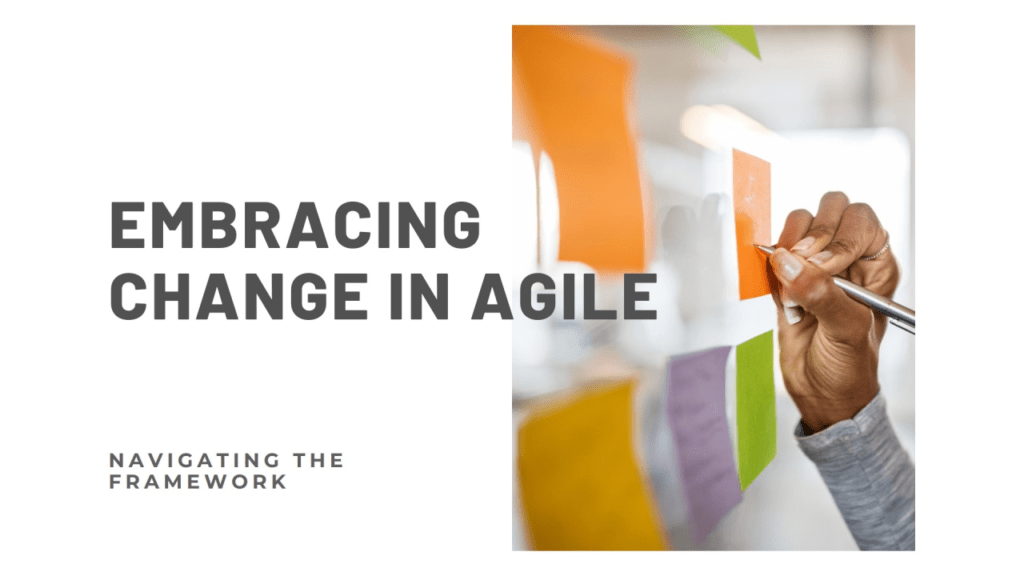
Change management in an Agile framework involves managing changes efficiently and effectively while maintaining the flexibility and responsiveness that Agile methodologies provide. Here are key strategies and practices for handling change management within an Agile framework:
1. Embrace Change
– Agile Mindset: Cultivate an Agile mindset that welcomes change and sees it as an opportunity for improvement.
– Customer Collaboration: Engage continuously with customers and stakeholders to ensure their needs and feedback are integrated into the development process.
2. Incorporate Changes Incrementally
– Iterative Development: Use short iterations (sprints) to incorporate changes incrementally, reducing the impact of changes on the overall project.
– Continuous Integration: Implement continuous integration and continuous delivery (CI/CD) practices to enable frequent and seamless integration of changes.
3. Prioritize Changes
– Backlog Management: Maintain a dynamic product backlog where changes are prioritized based on business value, urgency, and impact.
– Product Owner Role: Ensure the Product Owner actively manages and prioritizes the backlog, balancing new changes with existing requirements.
4. Transparent Communication
– Daily Stand-ups: Use daily stand-up meetings to discuss and address any changes, ensuring the team is aware and aligned.
– Sprint Reviews: Conduct sprint reviews to demonstrate progress, gather feedback, and discuss any new changes that need to be addressed in the upcoming sprints.
5. Adaptive Planning
– Rolling Wave Planning: Use rolling wave planning to adapt plans based on the latest information and feedback, allowing for adjustments as the project progresses.
– Flexible Roadmaps: Develop flexible roadmaps that can accommodate changes without derailing the project.
6. Risk Management
– Continuous Risk Assessment: Continuously assess and manage risks associated with changes, developing mitigation strategies as needed.
– Fail Fast: Adopt a “fail fast” approach to identify and address issues early, minimizing the impact of changes.
7. Stakeholder Involvement
– Regular Feedback: Encourage regular feedback from stakeholders through demos, reviews, and direct communication.
– Stakeholder Workshops: Conduct workshops and collaborative sessions with stakeholders to gather insights and ensure alignment on changes.
8. Documentation and Knowledge Sharing
– Lean Documentation: Maintain lean documentation that is just enough to capture essential information about changes and decisions.
– Knowledge Sharing: Foster a culture of knowledge sharing where team members document and share insights about changes and their impacts.
9. Empowered Teams
– Self-Organizing Teams: Empower teams to make decisions regarding changes, allowing them to adapt quickly and efficiently.
– Cross-Functional Skills: Develop cross-functional skills within the team to handle changes without dependency on external resources.
10. Continuous Improvement
– Retrospectives: Use sprint retrospectives to reflect on how changes were handled and identify opportunities for improvement.
– Kaizen: Implement the Kaizen philosophy of continuous improvement to refine processes and adapt to changes more effectively.
Example Practices
1. Change Requests:
– Implement a lightweight process for handling change requests that allows for quick assessment and prioritization.
– Ensure change requests are reviewed and approved by the Product Owner and relevant stakeholders.
2. Impact Analysis:
– Conduct impact analysis for significant changes to understand their effect on scope, schedule, and resources.
– Adjust sprint goals and plans based on the impact analysis to ensure realistic commitments.
3. Agile Contracts:
– Use Agile contracts with clients and stakeholders that allow for scope flexibility and iterative delivery, aligning with the Agile principles of responding to change.
By integrating these strategies into your Agile practices, you can manage changes effectively, ensuring that the project remains on track while delivering value to stakeholders and maintaining the flexibility that Agile methodologies offer.

Leave a Reply